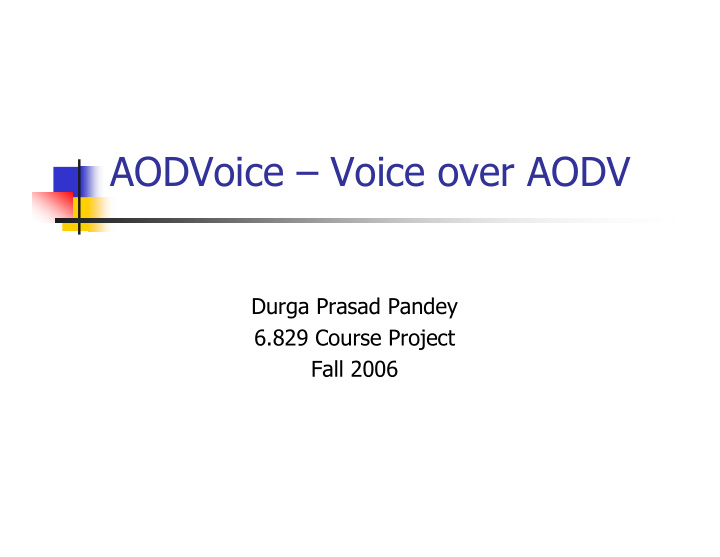



AODVoice – Voice over AODV Durga Prasad Pandey 6.829 Course Project Fall 2006
Wireless Traditional – node is one hop away from access point Ad-hoc no access point multiple hops are the norm nodes theselves forward packets. People come and go as they please Collaborate on the fly(cool term!)
AODV One of the most popular ad-hoc wireless routing protocols Reactive - Only when you desire Deletes non-used nodes from RT ~ 10 seconds AODV-UU
Motivation? Why Voice? Heavy enough to stress the wireless network and reveal weaknesses Time sensitive Video can buffer, sensors don’t send much data Its an application!
Have a compelling need? ;) 5000000 Children’s Laptops (OLPC) Mesh networking enabled Huge potential for on the fly voice conferencing, playing! Testbed and Usebed.
What did we do? A C B Call between A and C, sometimes goes through B
Approach Play an audio file over a SIP phone repeatedly and see how well it is received Initial approach: Play sound file at A’s speaker Capture it with microphone Send it over linphone Play linphone output on speaker Capture with microphone and record
How dumb!
Refined approach Use Jack: outputs audio from one application to another application, very low latency! At A: alsaplayer o/p linphone i/p At C: linphone o/p rezound i/p What these are: Alsaplayer =jack capable music player Linphone = SIP phone Rezound = sound recorder/player/mixer
Where did this happen?
Specifically!
Which song have you heard 500 times in the last week?
Measuring voice quality ITUT recommendation PESQ: Perceptual Evaluation of Sound Quality Mean opinion score(MOS) Scale 0 = worst to 4.5 = best 2+ = comprehensible Why not human ear? Not an objective, consistent instrument Considered most accurate speech quality standard Measures effects of dustortions such as delay, noise etc to model and predict subjective quality
Results – One hop fixed One Hop MOS variation with time 4.5 4 3.5 3 PESQ MOS 2.5 2 1.5 1 0.5 0 1 3 5 7 9 11 13 15 17 19 21 23 25 27 29 31 33 35 Time
Effect of using Jack One HOP MOS variation for fixed position 4.5 4 3.5 3 PESQ MOS 2.5 Series1 Series2 2 1.5 1 0.5 0 1 2 3 4 5 6 7 8 9 10 11 12 13 14 15 16 17 18 19 20 21 22 23 24 25 26 27 28 29 30 31 32 33 34 35 36 Time
Results – 1 hop moving A verage PESQ MOS variation with distance for 1-hop 4.5 4 3.5 3 PESQ MOS 2.5 2 1.5 1 0.5 0 1 2 3 4 5 6 7 8 9 Distance
Results: 1 to 2 hops, moving MOS variation when number of hops changes 4.5 4 3.5 3 MOS Score 2.5 2 1.5 1 0.5 0 1 2 3 4 5 6 7 8 9 10 11 12 13 14 15 16 17 18 19 20 21 22 23 Distance
Results: Hop oscillations MOS Oscillation at Hop threshold 3.5 3 2.5 PESQ MOS 2 1.5 1 0.5 0 1 2 3 4 5 6 7 8 9 10 11 12 13 14 15 16 17 18 19 20 21 22 23 Time
Observations Ping not reliable? Obstructions more lethal than distance +ve control signals might not imply data is reaching destination Assymetric signalling If routing is stable, 2 hop voice not bad Wireless signals can vary a lot!
Future Work More frequent hellos Configure(hardwire) for 2/more hops and measure MOS Try ETX Measure buffering delays, which might become significant with many hops
Thanks! Special thanks to Dina, Rob and Sachin for excellent suggestions To Kwan for asking: Can’t you connect a wire between speaker and microphone ports on a computer!
Recommend
More recommend